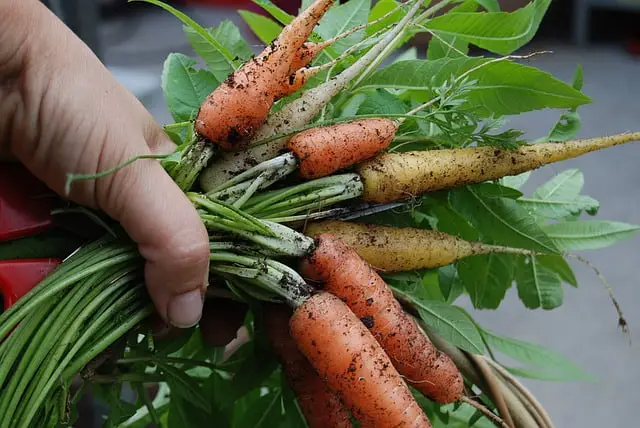Growing Carrots – Introduction:
As it is for growing any vegetables, knowing how to grow carrots properly can save a lot of grief and heartache when it comes to harvest time. Carrots in particular are prone to a pest called the carrot fly (Chamaepsila rosae ).
).
This is a destructive pest also known to attack parsnips and celery, and so must be looked out for. That aside, growing carrots is not at all difficult if certain preparations are made that can ensure a good healthy crop of delicious fresh carrots for the table.
Just like onions and tomatoes, carrots are a chef’s favourite as they can be included in a multitude of different dishes, and so are counted in the ‘must have’ vegetables in all the top restaurant kitchens. Being rich in vitamin A and calcium, carrots are delicious, steamed, boiled, and even roasted with a honey and orange glaze!
How To Make Sandy Soil For Carrots
Carrots prefer a light sandy soil and preferably a situation where they can get most of the days sunshine; though they can stand a little shade, particularly in hotter climates. They must also be grown in soil that is free from stones, if you are to avoid the ‘clubbing’ effect that means the carrots grow all twisted and miss-shaped.
Sandy soil is easily made by adding a few handfuls of soil to every square foot of growing mix. Adding vermiculite also helps with nutrient and water retention so that the soil will not drain away too fast.
For this reason I always prefer to grow carrots in a raised bed, as it is easier to tend, and the soil can be better controlled to produce a sandy light soil, free from stones, that the growing carrots love.
Growing carrots from seed:

Once the soil is prepared, then it is time to plant the carrot seed. This is a simple process that involves making a very shallow groove in the soil, and sprinkling the carrot seeds along the groove quite sparingly. Seed is then lightly covered up with soil. If planting before late march then they are best covered with a polythene cloche to encourage growth.
Rows should be approx. 6 inches apart. Shortly after the carrots have germinated, and have grown 2-3 inches in height; I would start to carefully thin out the plants to about 4 inches apart.
To help avoid the dreaded carrot fly, be very careful with this process, causing as little disturbance as possible to the remaining plants. A handy tip would be to trim of the foliage of the seedlings you do not want, just below the surface.
Remove all remaining foliage away from the carrot patch, as this will just attract the carrot fly.
How To Avoid Carrot Club Root
If you want to grow carrots that look like the ones in the picture – then try transplanting your seedlings! However presuming you want straight, healthy roots then avoid transplanting and follow the process described above.
Can You Transplant Carrot Thinnings?
In the previous paragraph I warned against transplanting your carrot thinnings – and this includes buying these timy packs of carrot seedlings from the local garden center.
However…If you are careful it is indeed possible to transplant carrot seedlings successfully if you follow these steps
- Carefully pull out your carrot thinnings and lay flat out, teasing the root so it is perfectly straight.
- Maake a deep hole in a suitable soil mix with a long thick pencil (about 6 inches.
- Carefully tease your seedling into the hole, being particularly careful not to bend the root and keeping it perfectly straight as it descends.
- Gently press the soil against the stem of the carrot to hold upright.
It’s definately worth a try – but don’t say I did not warn you!
Avoiding The Carrot Fly
Carrot fly is the carrots worst enemy by far. It is attracted to the smell of the carrot foliage, and from there descends to lay it’s eggs at the base of the foliage where it meets the soil.
It is the larva of the carrot fly that does the damage, by burrowing into the top of the carrot. First signs will be the leaves of the plant turning yellow, and the plant dying.
There is unfortunately no cure as yet for carrot fly devastation, but fortunately there are preventative measures you can take.
- First of all is to keep in mind that carrot fly are low flying insects. For this reason it is best to grow the carrots in a raised bed if possible, about 1 foot (300mm) of the ground, or more is preferred.
- Next tip is to cover the plants with a fleece material to prevent the fly’s from landing and laying there eggs on the carrots.
- Remove any carrot foliage thinning’s away from the carrot patch, so that the smell does not attract the carrot fly
- Try growing following companion planting guidelines and growing Allium plants such as garlic, to help disguise the smell of the carrots and distract the fly from the growing carrots.
How Store Carrots Over Winter
From about July onwards, you now have a successful carrot crop to harvest – hopefully ! Mostly you just need to harvest the carrots as they are needed. However they can be stored by cutting off the foliage with sharp scissors about 1 inch above the carrot, then placing on a bed of dry sand, in a garden shed.
If you are fortunate enough to have or are building a root celler , then all the better. Root vegetables like carrots, parsnips, turnips etc, store far better in a root celler where there is the right temperature and humidity to keep them fresh for meny months.
, then all the better. Root vegetables like carrots, parsnips, turnips etc, store far better in a root celler where there is the right temperature and humidity to keep them fresh for meny months.
Make sure the carrots do not touch, and inspect regularly to make sure there are none rotting.
This way the carrots can be kept fresh and wholesome over the winter months, but make sure they are kept frost-free and lightly covered over with sacking or some similar material. Knowing these basics of how to grow carrots should help ensure a healthy crop.



